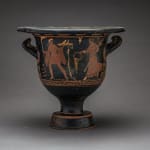Apulian Red-Figure Bell Krater, 400 BCE - 300 BCE
Terracotta
31.8 x 29.2 cm
12 1/2 x 11 1/2 in
12 1/2 x 11 1/2 in
SF.001
Further images
An essential vessel for anyone wishing to partake in the Bacchic pastime of wine-drinking, this wide-mouthed bell krater was specifically designed for holding large quantities of liquid; as it was...
An essential vessel for anyone wishing to partake in the Bacchic pastime of wine-drinking, this wide-mouthed bell krater was specifically designed for holding large quantities of liquid; as it was considered barbaric for wine to be drunk neat (and a privilege only enjoyed by Bacchus/Dionysus and his entourage who could handle such a level of intoxication) wine would be mixed with water, usually 1 part to 3. As such, craters provided an ideal large surface area for decoration, and as wine was of utmost importance to the Symposium, kraters would usually take centre place, and as such, the decoration of such vessels were geared towards such gatherings and attempted to provide subject matter for philosophical debate, or more usually, for titillation.
The obverse of this krater his highly jovial. To the right is a woman, her finely pleated dress swept to one side as she leaps in dance. In one hand she holds a Thyrsus, and in the other a garland. She is adorned with bracelets, necklaces, earrings, and a headpiece. In front of her, and showcasing the artist’s skill at depicting a nude figure in contraposto, is her fellow celebrant, a nude male. Draped around his elbows is his cloak, and he too wears a decorative headpiece. In one hand he holds a torch, possibly to light the way, and in the other he holds a large plate with grapes. This is clearly a Bacchic procession, an apt decoration for such a vessel. Indeed in the background is a bucrania, the skull of a sacred bull, iconography often attributed to Dionysus and his role in resurrection (his name means ‘twice born’.) Both figures are finely drawn, the skill of the artist showcased in his ability to depict movement and the body’s reaction to it. The added yellow for detail adds another dimension to the scene, and is typical of 4th Century B.C. vase painting. On the reverse, as is typical with drinking vessels, is a more sombre scene, the intention being to provide a conversational dichotomy. Two men stand facing each other, both wrapped in a travellers cloak and holding a walking stick. Between them is a tombstone.It could be that both figures travelled to visit the tomb of a loved one, or it could be that both are travelling on their way to death. It would be these kind of discussions that the decoration of this vase would have brought. A fine Greek key motif provides the platform for all these figures to stand upon, and decorative palmettes separate the two scenes, being placed under each handle. As is usual for these vessels, a band of vine leaves run around the top.
The obverse of this krater his highly jovial. To the right is a woman, her finely pleated dress swept to one side as she leaps in dance. In one hand she holds a Thyrsus, and in the other a garland. She is adorned with bracelets, necklaces, earrings, and a headpiece. In front of her, and showcasing the artist’s skill at depicting a nude figure in contraposto, is her fellow celebrant, a nude male. Draped around his elbows is his cloak, and he too wears a decorative headpiece. In one hand he holds a torch, possibly to light the way, and in the other he holds a large plate with grapes. This is clearly a Bacchic procession, an apt decoration for such a vessel. Indeed in the background is a bucrania, the skull of a sacred bull, iconography often attributed to Dionysus and his role in resurrection (his name means ‘twice born’.) Both figures are finely drawn, the skill of the artist showcased in his ability to depict movement and the body’s reaction to it. The added yellow for detail adds another dimension to the scene, and is typical of 4th Century B.C. vase painting. On the reverse, as is typical with drinking vessels, is a more sombre scene, the intention being to provide a conversational dichotomy. Two men stand facing each other, both wrapped in a travellers cloak and holding a walking stick. Between them is a tombstone.It could be that both figures travelled to visit the tomb of a loved one, or it could be that both are travelling on their way to death. It would be these kind of discussions that the decoration of this vase would have brought. A fine Greek key motif provides the platform for all these figures to stand upon, and decorative palmettes separate the two scenes, being placed under each handle. As is usual for these vessels, a band of vine leaves run around the top.





